Antonine Wall: Difference between revisions
No edit summary |
|||
| (2 intermediate revisions by the same user not shown) | |||
| Line 31: | Line 31: | ||
In mediæval histories, such as the chronicles of John of Fordun, the wall is called ''Gryme's dyke''. Fordun says that the name came from the grandfather of the imaginary king Eugenius son of Farquahar. This evolved over time into Graham's dyke – a name still found in [[Bo'ness]] at the wall's eastern end – and then linked with Clan Graham. | In mediæval histories, such as the chronicles of John of Fordun, the wall is called ''Gryme's dyke''. Fordun says that the name came from the grandfather of the imaginary king Eugenius son of Farquahar. This evolved over time into Graham's dyke – a name still found in [[Bo'ness]] at the wall's eastern end – and then linked with Clan Graham. | ||
Of note is that ''Graeme'' in some parts of the north is a nickname for the devil, as 'Grim' was in Old English a by-name for Woden and thus for the Devil: the Roman Limes in Southern Germany are likewise often called 'Teufelsmauer' ("Devil's Wall"). The same name is found as ''Grim's Ditch'' in several places in the south of Britain in connection with early ramparts, as for example near [[Wallingford]] (Berkshire) or between [[Berkhamsted]] (Hertfordshire) and [[Bradenham]] (Buckinghamshire). | Of note is that ''Graeme'' in some parts of the north is a nickname for the devil, as 'Grim' was in Old English a by-name for Woden and thus for the Devil: the Roman Limes in Southern Germany are likewise often called 'Teufelsmauer' ("Devil's Wall"). The same name is found as ''Grim's Ditch'' in several places in the south of Britain in connection with early ramparts, as for example near [[Wallingford]] (Berkshire) or between [[Berkhamsted]] (Hertfordshire) and [[Bradenham, Buckinghamshire|Bradenham]] (Buckinghamshire). | ||
Other names used by antiquarians include the Wall of Pius and the Antonine Vallum, after Antoninus Pius.<ref>Earthwork of England: prehistoric, Roman, Saxon, Danish, Norman and mediæval - Page 496, by Arthur Hadrian Allcroft</ref><ref>'Transactions of the Woolhope Naturalists' Field Club - Page 255, by Woolhope Naturalists' Field Club, Hereford, England, G. H. Jack, 1905</ref> Hector Boece in his 1527 ''History of Scotland'' called it the "wall of [[Abercorn]]", repeating the story that it had been destroyed by Graham.<ref>Boece, Hector, ''Historia Gentis Scotorum'', (1527), book 7, chapter 16</ref> | Other names used by antiquarians include the Wall of Pius and the Antonine Vallum, after Antoninus Pius.<ref>Earthwork of England: prehistoric, Roman, Saxon, Danish, Norman and mediæval - Page 496, by Arthur Hadrian Allcroft</ref><ref>'Transactions of the Woolhope Naturalists' Field Club - Page 255, by Woolhope Naturalists' Field Club, Hereford, England, G. H. Jack, 1905</ref> Hector Boece in his 1527 ''History of Scotland'' called it the "wall of [[Abercorn]]", repeating the story that it had been destroyed by Graham.<ref>Boece, Hector, ''Historia Gentis Scotorum'', (1527), book 7, chapter 16</ref> | ||
| Line 81: | Line 81: | ||
==See also== | ==See also== | ||
* [[Hadrian's Wall]] | *[[Hadrian's Wall]] | ||
==Outside links== | ==Outside links== | ||
{{commons}} | {{commons}} | ||
*Location map: {{wmap| | *Location map: {{wmap|55.967|-4.067}} | ||
*[https://www.historicenvironment.scot/advice-and-support/listing-scheduling-and-designations/world-heritage-sites/antonine-wall/ The Antonine Wall] - Historic Environment Scotland | |||
*[ | |||
*[http://www.antoninewall.org/ Antonine Wall.org] | *[http://www.antoninewall.org/ Antonine Wall.org] | ||
*[http://www.antonine-way.co.uk The Antonine Way] | *[http://www.antonine-way.co.uk The Antonine Way] | ||
| Line 105: | Line 104: | ||
{{World Heritage Sites}} | {{World Heritage Sites}} | ||
[[Category:Roman sites in Dunbartonshire]] | |||
[[Category:Roman sites in Lanarkshire]] | |||
[[Category:Roman sites in Stirlingshire]] | |||
[[Category:Roman sites in West Lothian]] | |||
[[Category:Roman walls]] | |||
[[Category:World Heritage Sites in the United Kingdom]] | [[Category:World Heritage Sites in the United Kingdom]] | ||
Latest revision as of 12:29, 3 February 2019
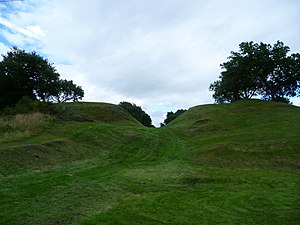
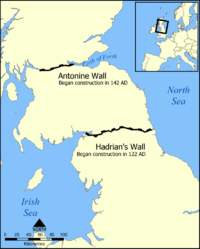
The Antonine Wall is a stone and turf fortification built by the Romans across the Central Lowlands, between the Firth of Forth and the Firth of Clyde. It was the northernmost frontier barrier of the Roman Empire, a hundred miles north of Hadrian's Wall.
The line of the wall is hard to trace for much of its course, but it runs from Old Kilpatrick, through Dunbartonshire, Lanarkshire, Dunbartonshire's detached east part, Stirlingshire and West Lothian, ending at Kinneil.
The wall when complete was approximately 40 miles long. It was built about 10 feet high and 16 feet wide. Security was bolstered by a deep ditch on the northern side. The barrier was the second of two great walls created by the Romans in Northern Britain, the other being the better known Hadrian's Wall to the south in Cumberland and Northumberland. The Antonime Wall was built of less sturdy materials and so its remains are less evident.
Construction began in 142 AD at the order of Roman Emperor Antoninus Pius, and took about 12 years to complete.
Pressure from the Caledonians may have led Antoninus to send the empire's troops further north. The wall was protected by 16 forts with a number of small fortlets between them; troop movement was facilitated by a road linking all the sites known as the Military Way. The soldiers who built the wall commemorated the construction and their struggles with the Caledonians in a number of decorative slabs, twenty of which still survive. Despite this auspicious start the wall was abandoned after only 20 years, and the garrisons relocated back to Hadrian's Wall. In 208 Emperor Septimius Severus re-established legions at the wall and ordered repairs; this has led to the wall being referred to as the Severan Wall. However, the occupation ended only a few years later, and the wall was never fortified again.
Most of the wall and its associated fortifications have been destroyed over time, but some remains are still visible. Many of these have come under the care of Historic Scotland and the oversight of the UNESCO World Heritage Committee.
Location and construction
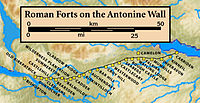
Emperor Antoninus Pius ordered the construction of the Antonine Wall around 142,[1] to secure the narrow passage between the Clyde and the Forth; a strategic position first noted by Agricola.[2] Supervision of the project was in the hands initially of Quintus Lollius Urbicus, Governor of Britannia, and the work took about twelve years to complete.[3] The resulting wall stretches 19 miles from Old Kilpatrick in Dunbartonshire on the Firth of Clyde to Kinneil near Bo'ness on the Firth of Forth. The wall was intended to extend Roman control to this line, a northward advance of 100 miles from Hadrian's Wall. However while the Romans did establish many forts and temporary camps further north of Antonine's wall in order to protect their routes to the north of Caledonia, they did not conquer the Caledonians, and the Antonine Wall suffered many attacks.
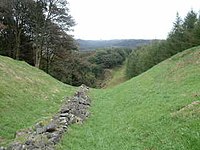
The Antonine Wall was shorter than Hadrian's Wall and built of turf on a stone foundation rather than of stone, but it was still an impressive achievement. The stone foundations and wing walls of the original forts demonstrate that the original plan was to build a stone wall similar to Hadrian's Wall, but this was quickly amended. As built, the wall was typically a bank, about 13 feet high, made of layered turves and occasionally earth with a wide ditch on the north side, and a military way on the south. The Romans initially planned to build forts every 6 miles, but this was soon revised to every 2 miles, resulting in a total of nineteen forts along the wall. The best preserved but also one of the smallest forts is Rough Castle Fort. In addition to the forts, there are at least 9 smaller fortlets, very likely on Roman mile spacings, which formed part of the original scheme, some of which were later replaced by forts.[4] The most visible fortlet is Kinneil, at the eastern end of the Wall, near Bo'ness.[5]
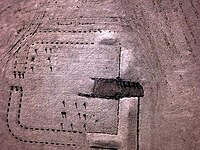
In addition to the line of the Wall itself there are a number of coastal forts both in the east (as at Inveresk) and west (Outerwards and Lurg Moor), which should be considered as outposts and/or supply bases to the Wall itself. In addition a number of forts farther north were brought back into service in the Gask Ridge area, including Ardoch, Strageath, Bertha[4] and probably Dalginross and Cargill.[6]
Abandonment
The wall was abandoned after only 20 years, when the Roman legions withdrew to Hadrian's Wall in 162, although there is evidence to suggest that they left the wall in 158/60, its reliability is unclear and over time reached an accommodation with the British tribes of the area whom they fostered as the buffer states which would later become "The Old North". After a series of attacks in 197, Emperor Septimius Severus arrived in northern Britain in 208 to secure the frontier, and repaired parts of the wall. Although this re-occupation only lasted a few years, the wall is sometimes referred to by later Roman historians as the Severan Wall. Gildas and scholars following him attributed Hadrian's Wall to Severus, apparently for this reason.
Post-Roman history
Grim's Dyke
In mediæval histories, such as the chronicles of John of Fordun, the wall is called Gryme's dyke. Fordun says that the name came from the grandfather of the imaginary king Eugenius son of Farquahar. This evolved over time into Graham's dyke – a name still found in Bo'ness at the wall's eastern end – and then linked with Clan Graham.
Of note is that Graeme in some parts of the north is a nickname for the devil, as 'Grim' was in Old English a by-name for Woden and thus for the Devil: the Roman Limes in Southern Germany are likewise often called 'Teufelsmauer' ("Devil's Wall"). The same name is found as Grim's Ditch in several places in the south of Britain in connection with early ramparts, as for example near Wallingford (Berkshire) or between Berkhamsted (Hertfordshire) and Bradenham (Buckinghamshire).
Other names used by antiquarians include the Wall of Pius and the Antonine Vallum, after Antoninus Pius.[7][8] Hector Boece in his 1527 History of Scotland called it the "wall of Abercorn", repeating the story that it had been destroyed by Graham.[9]
World Heritage status
In 2008 the Antonine Wall was accepted for World Heritage status by the international conservation body UNESCO, as an extension to the World Heritage Site "Frontiers of the Roman Empire".[10][11]
Historic Environment Scotland
Several individual sites along the line of the wall are in the care of Historic Environment Scotland. These are:
- Bar Hill Fort
- Bearsden Bath House
- Castlecary
- Croy Hill
- Dullatur
- Rough Castle
- Seabegs Wood
- Watling Lodge
- Westerwood
All sites are unmanned and open at all reasonable times.[12]
Mapping the wall
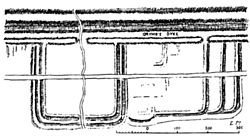
The first capable effort to systematically map the Antonine Wall was undertaken in 1764 by William Roy,[13] of the Ordnance Survey. He provided accurate and detailed drawings of its remains, and where the wall has been destroyed by later development, his maps and drawings are now the only reliable record of it.
In fiction
The Northern Wall is depicted in some of Rosemary Sutcliff's historical fiction novels; as a fully functioning outpost of Roman power in The Mark of the Horse Lord, and as an abandoned ruin in Frontier Wolf.
In Max Brooks's post-apocalyptic novel World War Z, the Antonine Wall marks the line at which the British establish their defence against the zombies and the beginning of their free zone.
In the A Song of Ice and Fire series by George R R Martin, the Antonine Wall geographically corresponds to the The Wall moreso than Hadrian's Wall.
See also
Outside links
| ("Wikimedia Commons" has material about Antonine Wall) |
- Location map: 55°58’1"N, 4°4’1"W
- The Antonine Wall - Historic Environment Scotland
- Antonine Wall.org
- The Antonine Way
- The Antonine Wall: Rome's Final Frontier, Hunterian Museum and Art Gallery, Glasgow
- Kinneil Attractions
- At the NA Pub??:
- Hillfoot
- The Roman Gak Project
- Roman Britain – The Antonine Wall
- The Antonine Wall and Bar Hill
- Princeton Encyclopedia of Classical Sites, 1976: "Antonine Wall"
- Information on the Antonine Wall - Clyde Waterfront Heritage
References
- ↑ Robertson, Anne S. (1960) The Antonine Wall. Glasgow Archaeological Society. p. 7.
- ↑ Tactitus: Agricola
- ↑ Breeze, David J. (2006) The Antonine Wall. Edinburgh. John Donald. ISBN 0-85976-655-1 p. 167.
- ↑ 4.0 4.1 L.Keppie, Scotland's Roman Remains. Edinburgh 1986)
- ↑ Historic Scotland - The Antonine Wall
- ↑ D.J.Woolliscroft & B.Hoffmann, Romes First Frontier. The Flavian occupation of Northern Scotland (Stroud: Tempus 2006)
- ↑ Earthwork of England: prehistoric, Roman, Saxon, Danish, Norman and mediæval - Page 496, by Arthur Hadrian Allcroft
- ↑ 'Transactions of the Woolhope Naturalists' Field Club - Page 255, by Woolhope Naturalists' Field Club, Hereford, England, G. H. Jack, 1905
- ↑ Boece, Hector, Historia Gentis Scotorum, (1527), book 7, chapter 16
- ↑ UNESCO World Heritage Centre. New Inscribed Properties
- ↑ "Wall gains World Heritage status'" BBC News. Retrieved 8 July 2008.
- ↑ Historic Scotland - Antonine Wall Overview
- ↑ Hübner, Emil (1886). "The Roman Annexation of Britain". in Hodgkin, Thomas. Archaeologia Aeliana. New. XI. Newcastle-Upon-Tyne: Society of Antiquaries of Newcastle upon Tyne. pp. 82–116. http://books.google.com/?id=4_4RAAAAYAAJ&pg=PA82.
| World Heritage Sites in the United Kingdom |
|---|
|
Bath • Blaenavon Industrial Landscape • Blenheim Palace • Canterbury Cathedral, St Augustine's Abbey & St. Martin's Church • Castles and Town Walls of King Edward I • Cornwall and West Devon Mining Landscape • Derwent Valley Mills • Durham Castle & Cathedral • Edinburgh Old Town & New Town • Forth Bridge • Frontiers of the Roman Empire: Antonine Wall & Hadrian's Wall • Giant's Causeway • Ironbridge Gorge • Jurassic Coast • Kew Gardens • Liverpool Maritime Mercantile City • Maritime Greenwich • New Lanark • Heart of Neolithic Orkney • Pontcysyllte Aqueduct • St Kilda • Saltaire • Stonehenge, Avebury & Associated Sites • Studley Royal Park & Fountains Abbey • Tower of London • Palace of Westminster, Westminster Abbey & St Margaret's Church |
